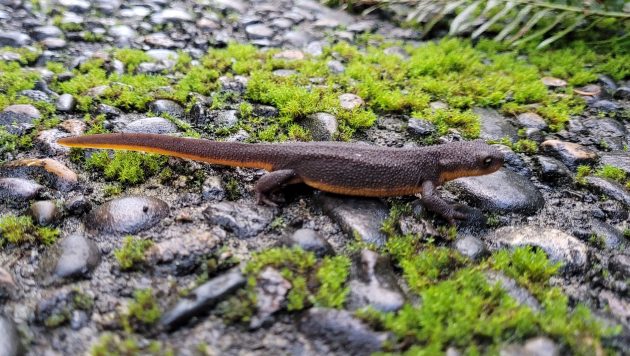
This little salamander put itself in danger of being stepped on outside our house today.
According to the Oregon Department of Fish and Wildlife, the little creature I almost stepped on today, which would have been an accident, was a salamander. More specifically, I’m pretty sure it was a newt.
On its website, the state wildlife department has a page on Oregon salamanders. There are 19 species of them, it says.
“While not all salamanders are newts, all newts are salamanders,” the website declares.
It also says, “The single newt in Oregon (Family: Salamandridae, Genus: Taricha), is also an aquatic breeder with a terrestrial adult stage. It can be distinguished from other salamanders by its rough skin and brightly colored belly.”
Rough skin and bright belly — that pretty much describes the little creature outside our house today. So, a newt it is.
I wish I knew more about the fauna that surrounds us, and about the flora too. Often, though, ODFW’s online publications are very helpful on the wildlife front, with short texts and nice illustrations.
If you want to learn more about those 19 species of salamanders, you can look them up here.
As for the differences between salamanders that are newts and salamanders that are not, there are several. One is that newts have all those warts on their skin. Other salamanders have smooth skin.
If you’re like me and didn’t know that, this day has been a success because we’ve learned something new. (hh)

Thanks for the cute picture and thank you for not stepping on the newt. Oh, you left the “f” off the word, “if,” so can I claim your sentence was unclear? (Yes, I know I said I wasn’t going to write, but I am cutting way back…insert smiley face here.)
Thanks for pointing out the typo.
Thanks – I too like information on our local critters!
We had a kazillion of these at our property on Puget Sound. It had sandy soil with alder, big leaf maple and Doug fir.
There are some in the woods behind my house
I’ve always thought that if you have salamanders in your neck of the woods that your space is still healthy and not too polluted
We had a bunch on my family’s property in Hugo (Oregon). We had a small pond/creek bed on the lower section of the property where most of them hung out, but off and on We would find them traversing our driveway when we were on a walk. We had a lot of pine, fir, some oak, and cedar trees. I can’t remember which trees were more predominant down by the pond, but a majority of the property was pine trees.
Many Long term Oregonians and indigenous peoples at least since the 19 30’s and 40’ have called them Waterdogs.